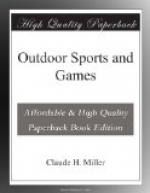Fish are very fickle in their tastes. What will be good bait one day will absolutely fail the next and sometimes even in an hour this same thing will take place. Why this is so no one has been able to explain satisfactorily, but that it is a fact no fisherman will deny. We should therefore have as great a variety of bait in our equipment as possible. Worms, crawfish, minnows, frogs, grasshoppers, grubs and helgramites are all good at times in fresh water, as well as various kinds of artificial baits, spoons, spinners, and rubber lures.
[Illustration: A trolling spoon]
Sometimes fish will take very unusual baits. Black bass have been caught on young bats. The famous old trout in the Beaverkill River in New York State, which had refused all the ordinary baits and flies that were offered him for years and that on bright days could be seen in a pool lying deep down in the water, finally fell a victim to a young mouse that was tied to the hook with pink silk.
Fly fishing is the most expert and scientific method of angling. It is the poetry of fishing. The fly fisherman usually wades in the brook or stream where he is fishing, although it is sometimes possible to cast a fly from the bank or a boat. It is useless to go fly fishing while there is snow water in the brooks but just as soon as the first warm days of spring come, then fishing is at its best.
The whole idea of casting a fly is to drop it in the most likely-looking places and to strike the fish just as soon as he seizes the hook. To do this we must always have the line under perfect control, therefore do not attempt to cast a line too great a distance. If we do not fix the hook into the fish’s mouth at the instant that he seizes the fly, he will very soon find that what he thought was a nice fat bug or juicy caterpillar is nothing but a bit of wool and some feathers with a sting in its tail, and he will spit it out before we can recover our slack line.
It is a common mistake to use flies that are too large. Ordinary trout flies are the proper size for bass and the smallest size trout flies are plenty large enough for trout. There are hundreds of kinds of flies of various combinations of colours and no one can say which is the best. This question has been argued by fishermen ever since the days of Izaak Walton.
The universal rule of trout and bass fishermen who use a fly is to select small dark flies for bright days or when the water is very clear or low and the more brightly coloured ones when the day is dark or the water dark or turbid. The fly book should contain a varied assortment to meet these conditions.




